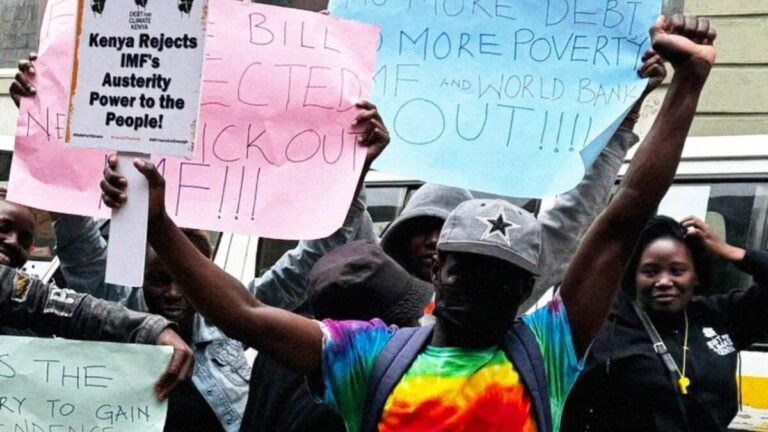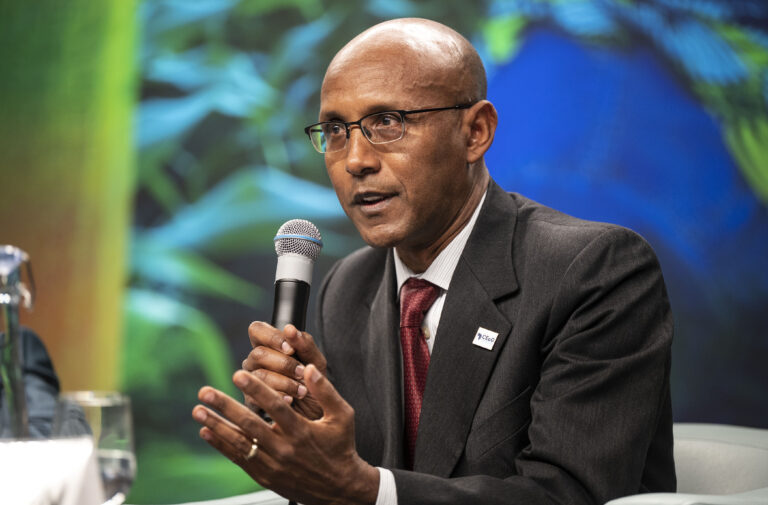
A community health worker checks blood sugar levels during an outreach clinic in rural Kenya . Photo/Courtesy
By Daisy Okiring
Homabay, Kenya, 6th August 2025
Every three days, 55-year-old Millicent Achieng leaves her home in Kokwanyo village, deep in Homa Bay County, to begin a punishing 14-kilometre trek to the nearest health dispensary. She doesn’t go to see a doctor—there’s rarely one available. She walks for insulin.
“I’m a widow. Sometimes I walk barefoot. I start at 5 a.m. to avoid the sun,” Millicent says, her fingers trembling from low blood sugar. “If I delay too long, I faint on the road.”
Millicent has lived with type 1 diabetes for 12 years. But what threatens her life more than the disease is the lack of access to consistent care. Her nearest health center in Ringa runs out of insulin regularly, and the referral hospital in Homa Bay town is two matatus and five hours away. With no stable income and five grandchildren under her care, Millicent’s diabetes is not just a diagnosis—it’s a daily fight for survival.
The slow killers in the shadows
According to the Ministry of Health (2023), over 3.3% of Kenyans are living with diabetes, but that number may be drastically underestimated due to lack of screening, misdiagnosis, and poor data collection. Non-communicable diseases (NCDs), including diabetes and hypertension, now account for 39% of all deaths in Kenya—double what it was in 2010.
A 2022 WHO report showed that diabetes causes at least 7,000 deaths annually in Kenya, but local experts believe the real number is much higher. In many rural communities, deaths from diabetic complications—kidney failure, stroke, amputations—go unrecorded.
Also Read: Pneumonia is a silent killer we can’t ignore
“We have an iceberg problem,” says Dr. Eva Njenga, chair of the Non-Communicable Diseases Alliance of Kenya. “What we see in clinics is just the tip. There are thousands dying at home, undiagnosed or untreated.”

Why diabetes is deadlier in Homa Bay
Despite its natural beauty and rich culture, Homa Bay County remains one of Kenya’s poorest regions. Nearly 60% of the population lives below the poverty line, according to the Kenya National Bureau of Statistics (2023). Health infrastructure is weak—few health centers have refrigeration for insulin, test kits are often out of stock, and nurses are overburdened.
“Sometimes, I go and they say there is no insulin,” says George Otieno, a 33-year-old fisherman and father of three. “They tell me to buy from a chemist in Kisumu. That’s 1,000 shillings for transport and another 2,000 for insulin. I can’t even afford to eat.”
Also Read: Daily dose lets men step up in family planning
In a 2023 study by Amref Health Africa, over 40% of rural diabetes patients in Western Kenya reported skipping doses or stopping insulin altogether due to cost and distance.

Children caught in the crossfire
Diabetes is also hitting younger people. In 2024, KEMRI (Kenya Medical Research Institute) reported a 52% increase in new cases of type 1 diabetes in children under 18 compared to a decade ago.
One such case is Victor Omondi, a 10-year-old boy from Kaksingri West in Homa Bay. Diagnosed with type 1 diabetes two years ago, Victor collapsed at school after a hypoglycemic episode. His mother now wakes at 2 a.m. to check his blood sugar with a flashlight.
“We’ve lost five children in this village in two years from diabetes,” says Sr. Dorcas, a community health worker. “Some were misdiagnosed with malaria. One died before they reached Homa Bay hospital.”

Global voices, local struggles
Globally, diabetes has become one of the top 10 causes of death, killing 1.5 million people annually according to WHO (2023). In Sub-Saharan Africa, the number of adults with diabetes is expected to double by 2045. Kenya is already feeling that pressure.“Non-communicable diseases are the new pandemic,” said Dr. Matshidiso Moeti, WHO Regional Director for Africa, during a 2024 summit. “Yet our health systems are still structured for malaria and HIV.”
Organizations like Novo Nordisk, Life for a Child, and Merck Foundation have been working with the Kenyan government to improve diabetes care, training nurses, setting up rural screening camps, and donating insulin. But supply chain issues, limited health budgets, and lack of awareness remain persistent barriers.
Culture and Stigma Compound the Crisis
In Homa Bay, some still associate diabetes with curses or “rich people’s disease.” This prevents early testing or care, especially among men.
“People say I brought the disease on myself, that I’m lazy,” says Josephine Atieno, 41, who had her leg amputated last year after an infected foot ulcer. “They don’t know I’ve never had money to buy shoes.”
Even in churches and schools, diabetes education is rare. Community health workers report being laughed at when they suggest diet changes or glucose testing.
A healthcare system on the brink
Kenya’s Universal Health Coverage (UHC) pilot programs promised improved access to chronic illness management. But in rural clinics, UHC cards often don’t cover insulin or blood glucose strips.
“What’s the use of free consultations if I still have to buy everything?” asks George Otieno. “It’s a lie.”
A 2023 study by Health Action International found that only 23% of rural health facilities in Kenya had all essential medicines for diabetes in stock. Meanwhile, insulin remains 3–4 times more expensive than WHO’s target price.

Pathways to hope
Despite the gloom, hope exists. In Ndhiwa Sub-County, a local NGO called Hope Beyond Diabetes has started a monthly diabetes clinic run by trained community health volunteers. They offer free screening, nutrition training, and peer counseling. In one year, they’ve reduced emergency admissions by 37%.
“People are learning to live, not just survive,” says Millicent Odhiambo, a retired nurse who founded the group after losing her sister to diabetic coma. “If we wait for Nairobi to solve this, our people will die.”

The road ahead
Kenya’s Ministry of Health has pledged to include insulin in the essential medicines budget for all counties and is piloting telemedicine in Nyanza for remote diabetes checkups. But for this to work, community education, transportation, and access to cold storage must be scaled.
As the world races toward innovation, villagers like Margaret still race against death, one footstep at a time.
“All I ask is to live long enough to see my grandchildren grow,” she whispers. “That is my prayer.”



